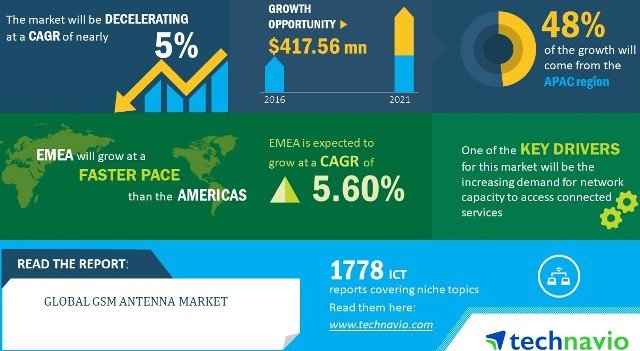 The GSM antenna market is expected to grow at a CAGR of close to 5 percent during 2017-2021 – fuelled by increase in capacity and the forthcoming 5G technology launch in 2019, according to the latest market research report by Technavio.
The GSM antenna market is expected to grow at a CAGR of close to 5 percent during 2017-2021 – fuelled by increase in capacity and the forthcoming 5G technology launch in 2019, according to the latest market research report by Technavio.
Advanced RF Technologies (ADRF), Communication Components, Cobham Wireless, CommScope, Bird Technologies, Ericsson, Huawei Technologies, ZTE, Comba Telecom, KATHREIN-Werke and Laird have presence in the global GSM antenna market.
Constant changes in GSM technologies will be one of the factors that will have a positive impact on the GSM antenna market. Telecom operators need to replace GSM antennas to support the newest GSM systems to meet their spectrum and frequency necessities.
Advantages of UWB such as the low-power transmission, low-power dissipation, and robustness for multi-path fading drive its increased adoption in many industries.
The main feature of UWB is low power transmission that can allow it to coexist with other wireless networking standards such as 802.11 local area network (LAN), 802.16 metropolitan area network (MAN), and wide area network (WAN).
Moreover, UWB densities are calculated for different GSM antenna systems, and the outcomes have resulted in no harmful interference between networks. These benefits of UWB will drive the market for GSM antenna and is expected to witness high growth.
LTE technology segment accounted for 46 percent share of the GSM antenna market in 2016. Main factors such as the higher data traffic compared to 3G data traffic due to better quality downloads, high use of social networks, and high volume of data usage will contribute to the growth of the LTE antenna market in the coming years.
Americas contributed 45 percent share of the global GSM antenna market powered by penetration of internet-enabled devices, increase in mobile data traffic due to the availability of faster internet connections.
American telecom operator Verizon Wireless is expanding its power efficiency program to deploy more small cell nodes installed with GSM antennas for LTE networks and reduce operational expenses (OPEX) on energy by half by 2020.
Mobile operators in North America outsourced their mobile backhaul networking requirements to wholesale mobile backhaul network operators. The network operators seek better, faster and more cost-effective ways to upgrade and maintain their mobile backhaul networks.
“This is necessary to keep pace with the ongoing growth in bandwidth growth and the performance required from 4G wireless services,” said Jujhar Singh, a lead analyst at Technavio for research on machine to machine (M2M) and connected devices.
